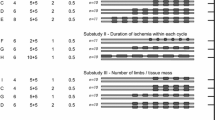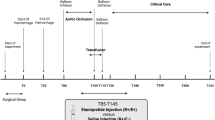Abstract
Purpose
We investigated whether bilateral, lower limb remote ischemic preconditioning (RIPC) improved long-term survival using a rat model of hemorrhagic shock/resuscitation.
Methods
Rats were anesthetized, intubated and ventilated, and randomly assigned to RIPC, induced by inflating bilateral pressure cuffs around the femoral arteries to 200 mmHg for 5 min, followed by 5-min release of the cuffs (repeated for 4 cycles), or control group (cuffs were inflated to 30 mmHg). Hemorrhagic shock was induced by withdrawing blood to a fixed mean blood pressure of 30 mmHg for 30 min, followed by 30 min of resuscitation with shed blood. Rats remained anesthetized for 1 h during which hemodynamics were monitored then they were allowed to survive for 6 weeks.
Results
The percentage of estimated total blood volume withdrawn to maintain a level of 30 mmHg was similar in both groups. RIPC significantly increased survival at 6 weeks: 5 of 27 (19%) rats in the control group and 13 of 26 (50%; p = 0.02) rats in the RIPC group survived. Blood pressure was higher in the RIPC group. The diastolic internal dimension of the left ventricle, an indicator of circulating intravascular blood volume, was significantly larger in the RIPC group at 1 h after initiation of resuscitation compared to the control group (p = 0.04). Left ventricular function assessed by fractional shortening was comparable in both groups at 1 h after initiation of resuscitation. Blood urea nitrogen (BUN) was within normal range in the RIPC group (17.3 ± 1.2 mg/dl) but elevated in the control group (22.0 ± 1.7 mg/dl) at 48 h after shock.
Conclusions
RIPC significantly improved short-term survival in rats that were subjected to hemorrhagic shock, and this benefit was maintained long term. RIPC led to greater circulating intravascular blood volume in the early phase of resuscitation and improved BUN.



Similar content being viewed by others
References
Vital signs: unintentional injury deaths among persons aged 0-19 years - United States, 2000-2009. MMWR Morb Mortal Wkly Rep. 2012(61):270–6.
Peitzman AB, Billiar TR, Harbrecht BG, Kelly E, Udekwu AO, Simmons RL. Hemorrhagic shock. Curr Probl Surg. 1995;32(11):925–1002.
Tisherman SA, Alam HB, Rhee PM, Scalea TM, Drabek T, Forsythe RM, et al. Development of the emergency preservation and resuscitation for cardiac arrest from trauma clinical trial. J Trauma Acute Care Surg. 2017;83(5):803–9.
Tisherman SA, Schmicker RH, Brasel KJ, Bulger EM, Kerby JD, Minei JP, et al. Detailed description of all deaths in both the shock and traumatic brain injury hypertonic saline trials of the Resuscitation Outcomes Consortium. Ann Surg. 2015;261(3):586–90.
Barbee RW, Reynolds PS, Ward KR. Assessing shock resuscitation strategies by oxygen debt repayment. Shock (Augusta, Ga). 2010;33(2):113–22.
Krausz MM, Ravid A, Izhar U, Feigin E, Horowitz M, Gross D. The effect of heat load and dehydration on hypertonic saline solution treatment of controlled hemorrhagic shock. Surg Gynecol Obstet. 1993;177(6):583–92.
Fulop A, Turoczi Z, Garbaisz D, Harsanyi L, Szijarto A. Experimental models of hemorrhagic shock: a review. Eur Surg Res. 2013;50(2):57–70.
Moochhala S, Wu J, Lu J. Hemorrhagic shock: an overview of animal models. Front Biosci. 2009;14:4631–9.
Candilio L, Malik A, Hausenloy DJ. Protection of organs other than the heart by remote ischemic conditioning. J Cardiovasc Med (Hagerstown). 2013;14(3):193–205.
Przyklenk K, Bauer B, Ovize M, Kloner RA, Whittaker P. Regional ischemic ‘preconditioning’ protects remote virgin myocardium from subsequent sustained coronary occlusion. Circulation. 1993;87(3):893–9.
Birnbaum Y, Hale SL, Kloner RA. Ischemic preconditioning at a distance: reduction of myocardial infarct size by partial reduction of blood supply combined with rapid stimulation of the gastrocnemius muscle in the rabbit. Circulation. 1997;96(5):1641–6.
Hausenloy DJ, Barrabes JA, Botker HE, Davidson SM, Di Lisa F, Downey J, et al. Ischaemic conditioning and targeting reperfusion injury: a 30 year voyage of discovery. Basic Res Cardiol. 2016;111(6):70.
Hess DC, Blauenfeldt RA, Andersen G, Hougaard KD, Hoda MN, Ding Y, et al. Remote ischaemic conditioning-a new paradigm of self-protection in the brain. Nat Rev Neurol. 2015;11(12):698–710.
Li C, Xu M, Wu Y, Li YS, Huang WQ, Liu KX. Limb remote ischemic preconditioning attenuates lung injury after pulmonary resection under propofol-remifentanil anesthesia: a randomized controlled study. Anesthesiology. 2014;121(2):249–59.
Czigany Z, Turoczi Z, Kleiner D, Lotz G, Homeyer A, Harsanyi L, et al. Neural elements behind the hepatoprotection of remote perconditioning. J Surg Res. 2015;193(2):642–51.
Brzozowski T, Konturek PC, Pajdo R, Kwiecien S, Sliwowski Z, Drozdowicz D, et al. Importance of brain-gut axis in the gastroprotection induced by gastric and remote preconditioning. J Physiol Pharmacol. 2004;55(1 Pt 2):165–77.
Saeki I, Matsuura T, Hayashida M, Taguchi T. Ischemic preconditioning and remote ischemic preconditioning have protective effect against cold ischemia-reperfusion injury of rat small intestine. Pediatr Surg Int. 2011;27(8):857–62.
Hu X, Yang Z, Yang M, Qian J, Cahoon J, Xu J, et al. Remote ischemic preconditioning mitigates myocardial and neurological dysfunction via K(ATP) channel activation in a rat model of hemorrhagic shock. Shock (Augusta, Ga). 2014;42(3):228–33.
Hu Y, Li T, Tang XF, Chen K, Liu L. Effects of ischemic preconditioning on vascular reactivity and calcium sensitivity after hemorrhagic shock and their relationship to the RhoA-Rho-kinase pathway in rats. J Cardiovasc Pharmacol. 2011;57(2):231–9.
Huang J, Xu D, Guo Q, Ou B, Ling Q, Li J, et al. Remote ischemic postconditioning improves myocardial dysfunction via the risk and safe pathways in a rat model of severe hemorrhagic shock. Shock (Augusta, Ga). 2018;49(4):460–5.
Leung CH, Caldarone CA, Wang F, Venkateswaran S, Ailenberg M, Vadasz B, et al. Remote ischemic conditioning prevents lung and liver injury after hemorrhagic shock/resuscitation: potential role of a humoral plasma factor. Ann Surg. 2015;261(6):1215–25.
Tamion F, Richard V, Lacoume Y, Thuillez C. Intestinal preconditioning prevents systemic inflammatory response in hemorrhagic shock. Role of HO-1. Am J Physiol Gastrointest Liver Physiol. 2002;283(2):G408–14.
Tamion F, Richard V, Renet S, Thuillez C. Intestinal preconditioning prevents inflammatory response by modulating heme oxygenase-1 expression in endotoxic shock model. Am J Physiol Gastrointest Liver Physiol. 2007;293(6):G1308–14.
Esiobu P, Childs EW. A rat model of hemorrhagic shock for studying vascular hyperpermeability. Methods Mol Biol. 2018;1717:53–60.
Delagarde H, Ouadraougo N, Grall S, Macchi L, Roy PM, Abraham P, et al. Remote ischaemic preconditioning in intermittent claudication. Arch Cardiovasc Dis. 2015;108(10):472–9.
Song SQ, Gan HL, Zhang JQ, Feng L, Sun JC, Wang SX. Post-conditioning through lower limb ischemia-reperfusion can alleviate lung ischemia-reperfusion injury. Int J Clin Exp Med. 2015;8(9):14953–61.
Zhu SB, Liu Y, Zhu Y, Yin GL, Wang RP, Zhang Y, et al. Remote preconditioning, perconditioning, and postconditioning: a comparative study of their cardio-protective properties in rat models. Clinics (Sao Paulo, Brazil). 2013;68(2):263–8.
Botker HE, Kharbanda R, Schmidt MR, Bottcher M, Kaltoft AK, Terkelsen CJ, et al. Remote ischaemic conditioning before hospital admission, as a complement to angioplasty, and effect on myocardial salvage in patients with acute myocardial infarction: a randomised trial. Lancet (London, England). 2010;375(9716):727–34.
Le Page S, Bejan-Angoulvant T, Angoulvant D, Prunier F. Remote ischemic conditioning and cardioprotection: a systematic review and meta-analysis of randomized clinical trials. Basic Res Cardiol. 2015;110(2):11.
Pan J, Li X, Peng Y. Remote ischemic conditioning for acute ischemic stroke: dawn in the darkness. Rev Neurosci. 2016;27(5):501–10.
Sloth AD, Schmidt MR, Munk K, Kharbanda RK, Redington AN, Schmidt M, et al. Improved long-term clinical outcomes in patients with ST-elevation myocardial infarction undergoing remote ischaemic conditioning as an adjunct to primary percutaneous coronary intervention. Eur Heart J. 2014;35(3):168–75.
Kottenberg E, Thielmann M, Bergmann L, Heine T, Jakob H, Heusch G, et al. Protection by remote ischemic preconditioning during coronary artery bypass graft surgery with isoflurane but not propofol - a clinical trial. Acta Anaesthesiol Scand. 2012;56(1):30–8.
Kleinbongard P, Peters J, Jakob H, Heusch G, Thielmann M. Persistent survival benefit from remote ischemic pre-conditioning in patients undergoing coronary artery bypass surgery. J Am Coll Cardiol. 2018;71(2):252–4.
Randhawa PK, Bali A, Jaggi AS. RIPC for multiorgan salvage in clinical settings: evolution of concept, evidences and mechanisms. Eur J Pharmacol. 2015;746:317–32.
Seal JB, Gewertz BL. Vascular dysfunction in ischemia-reperfusion injury. Ann Vasc Surg. 2005;19(4):572–84.
Conceicao FG, Conde CM, Svensjo E, Bottino DA, Bouskela E. Preconditioning of the response to ischemia/reperfusion-induced plasma leakage in hamster cheek pouch microcirculation. Clinics (Sao Paulo, Brazil). 2012;67(8):923–9.
Heusch G. The coronary circulation as a target of cardioprotection. Circ Res. 2016;118(10):1643–58.
Li Z, Jin ZQ. Ischemic preconditioning enhances integrity of coronary endothelial tight junctions. Biochem Biophys Res Commun. 2012;425(3):630–5.
Duan C, Yang G, Li T, Liu L. Advances in vascular hyporeactivity after shock: the mechanisms and managements. Shock (Augusta, Ga). 2015;44(6):524–34.
Moro L, Pedone C, Mondi A, Nunziata E, Antonelli Incalzi R. Effect of local and remote ischemic preconditioning on endothelial function in young people and healthy or hypertensive elderly people. Atherosclerosis. 2011;219(2):750–2.
Tokuno S, Chen F, Pernow J, Jiang J, Valen G. Effects of spontaneous or induced brain ischemia on vessel reactivity: the role of inducible nitric oxide synthase. Life Sci. 2002;71(6):679–92.
Torbati D, Totapally BR, Camacho MT, Wolfsdorf J. Experimental critical care in ventilated rats: effect of hypercapnia on arterial oxygen-carrying capacity. J Crit Care. 1999;14(4):191–7.
Suzuki A, Iwamoto T, Sato S. Effects of inspiratory oxygen concentration and ventilation method on a model of hemorrhagic shock in rats. Exp Anim. 2002;51(5):477–83.
Petersson J, Glenny RW. Gas exchange and ventilation-perfusion relationships in the lung. Eur Respir J. 2014;44(4):1023–41.
Funding
This work was supported by the Office of the Assistant Secretary of Defense for Health Affairs, through the Peer Reviewed Medical Research Program under Award No.W81XWH-16-1-0606.
Author information
Authors and Affiliations
Corresponding author
Ethics declarations
Conflict of Interest
The authors declare that they have no conflict of interest.
Ethical Approval
All applicable international, national, and/or institutional guidelines for the care and use of animals were followed.
Disclaimer
Opinions, interpretations, conclusion, and recommendations are those of the authors and are not necessarily endorsed by the Department of Defense.
Additional information
Publisher’s Note
Springer Nature remains neutral with regard to jurisdictional claims in published maps and institutional affiliations.
Electronic Supplementary Material
ESM 1
(DOCX 22 kb)
Rights and permissions
About this article
Cite this article
Dai, W., Shi, J., Carreno, J. et al. Improved Long-term Survival with Remote Limb Ischemic Preconditioning in a Rat Fixed-Pressure Hemorrhagic Shock Model. Cardiovasc Drugs Ther 33, 139–147 (2019). https://doi.org/10.1007/s10557-019-06860-6
Published:
Issue Date:
DOI: https://doi.org/10.1007/s10557-019-06860-6




